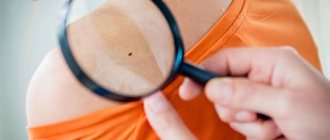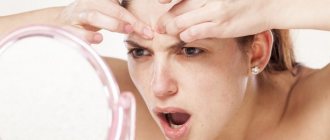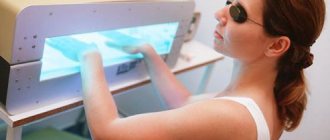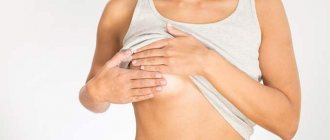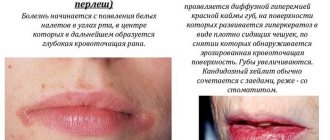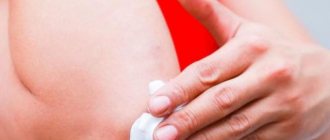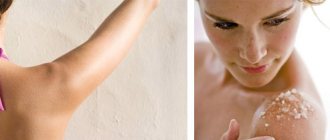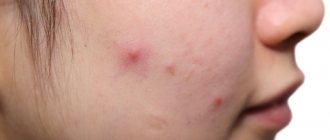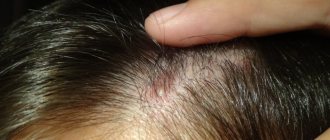Milium (horny cyst, whitehead, “millet”) is an epidermal cystic formation at the mouth of the hair follicle, looking like a small white grain. Typically, milia are localized on the face in areas with relatively thin skin, very rarely on the body, and exist for a long period without any changes. Milia are a fairly common cosmetic problem and can occur at any age. Whiteheads appear especially often during puberty; also often found in newborn babies (neonatal acne). Female representatives are more susceptible to the appearance of milia.
Causes of whiteheads
Prosyanka owes its appearance to 2 factors:
- disruption of the functioning of the glands that produce sebum;
- disruption of the process of desquamation of the epidermis.
Wen (or milia) are frequent guests on the face of patients with thick, oily seborrhea.
In such patients:
- the sebaceous glands are too active (hyperfunction is observed);
- the chemical composition of the sebum secreted by the glands is altered (too much stearic acid and not enough linoleic acid).
At the same time, sebum becomes viscous and thick. Thick sebum is not able to properly lubricate the skin and maintain the desired threshold of skin keratinization (keratinization). Mixes with keratinized particles of dying epidermis. This “plug” tightly “closes” the follicle.
As a result, the patient can expect:
- hyperkeratosis in the hair follicle area;
- blockage with thick greasy and fatty masses;
- formation of comedones of 2 types (open or blackheads, and closed or whiteheads).
The appearance of milia is often accompanied by the formation of both common (vulgar) acne on the skin and deep cysts formed in the sebaceous glands - atheromas.
Attention: the risk of developing milia is higher during puberty.
Comede-forming factors
Factors that contribute to blood thickening include:
| Factor | Explanation |
| Diet violation. A diet of fast food, chips, cakes, cabannossi and cola is not conducive to clear skin. | Saturation of the body with spices, pickles, marinades, sweets leads to increased load on the pancreas and hypatobiliary system (liver + bile ducts). Overload of these systems causes metabolic disorders (breakdown and transformation) of fats. As a result, a large amount of cholesterol is formed, the sebaceous glands actively produce (excrete) sebum. |
| Working with facial skin using comedogenic cosmetics | By overdrying the skin (teenagers are especially guilty of this) with various drying agents, you disrupt the regulation of sebum (sebum) production. And this leads to blockage of pores, gland ducts, and hair follicles. That is, directly to the formation of white and blackheads. |
| Skin disorders | Peels, dermatobrasion, abrasions and wounds - all this provokes disruption of the sebaceous glands |
| Hormonal dysfunction | The sebaceous glands are sensitive to the level of hormones in the blood. Hormonal imbalances affect skin condition |
| Disturbances in the functioning of the autonomic system (autonomic part of the nervous system), its lability (instability) increases the risk of the formation of comedones and sebaceous duct cysts | The nervous system takes part in regulating the functioning of all glands. Its excessive activity stimulates sebium production |
| Lack of vitamins (hypovitaminosis, vitamin deficiency) and gastrointestinal diseases (preventing the normal supply of vitamins to the body) | The sebaceous glands are especially sensitive to the content in the blood. |
This is interesting: women more often suffer from the formation of milia, since hormonal surges occur in their bodies every month, and especially strong disturbances await them during pregnancy and menopause.
Primary and secondary milia: main causes of development
Milium is usually divided:
- to the primary one - it appears for one single reason - genetics! Genetic predisposition, supported by improper skin care or diet, becomes a real fatty cyst;
- secondary - whiteheads appear after inflammatory processes of the skin and injuries. Keep in mind that injuries are not only the consequences of contact of the facial skin with a suddenly rearing road or the claws of a cat gone mad with rage (that is, abrasions and scratches).
Secondary milia can be caused by:
- skin burn;
- facial surgery;
- laser therapy;
- dermatobrasion.
In addition to the “human factor,” that is, the desire to improve one’s face, diseases that are difficult to influence also lead to unpleasant consequences. These are mainly skin diseases (sarcoidosis of the skin, cutaneous porphyria, tuberculous lupus, etc.)
This is interesting: in men, milia can be combined with benign tumors of the skin appendages. Usually this is a family affair. That is, such cases haunt the male half of the family.
Secondary milia can regress without medical intervention.
Whiteheads in newborns
In children who have just been born, the sebaceous ducts are narrowed. At the same time, in order for the baby’s skin to adapt to an aggressive external environment, it must produce a lot of lubricant. Therefore, the sebaceous ducts are often buried with a sebaceous “plug”.
Babies often develop sebaceous cysts:
- on the wings of the nose;
- on the chin;
- on the cheeks.
This is secondary milia and with proper care it will regress.
Education process
Whiteheads are formed as a result of blockage of the small openings of the sweat glands. This occurs due to excessive sebum production to moisturize the skin. The excess accumulates at the mouth of the pore, which gradually stretches. Dead particles of the epidermis are added to it, becoming an excellent breeding ground for pathogenic bacteria. An inflammatory process begins in the pore and unpresentable acne appears instead of smooth skin. The rash looks like small elevations above the surface of the skin, the size of their white top does not exceed the size of a match head.
Localization of milia
- Most often, whiteheads occur under the skin on the face, their number is insignificant. They can be deployed:
- under the eyes;
- on eyelids;
- on the cheekbones;
- at the bottom of the chin;
- nose
Under certain conditions, there are many whiteheads on the skin of the face and they are noticeable upon visual inspection. This localization is typical for women, but also for men with sensitive skin there is a risk of becoming the owner of millet on the face. The same characteristic of the epidermis in the scrotum area makes this part of the male body a problem area. During puberty, acne and blackheads concentrate on the back, and in girls also on the chest.
Symptoms of milia
Millet is small, round and dense white nodules that protrude above the skin, painless, with clear contours. They vaguely resemble millet grains, hence the name.
Characteristic features of “millet grains” on the face:
- non-inflammatory head;
- lack of natural access to the surface (cannot be squeezed out like a black eel);
- the years practically do not change in size.
It is necessary to differentiate this disease from other skin lesions. For example, fibromas or xanthelasmas of the eyelids.
Effective Treatments
The choice of treatment method depends on the cause of acne formation under the skin. To diagnose the problem, you need to consult a cosmetologist or dermatologist. If you have existing diseases of the internal organs, it is recommended to visit a therapist and specialists.
It is important to carry out the treatment program under dermatological control and combine it with adequate cosmetic procedures.
Treatment of whiteheads at home
How to get rid of acne at home? For treatment to be effective, it is necessary to follow the principle of comprehensiveness in facial skin care.
To do this, you need to follow three steps step by step:
- Cleanse your facial skin.
- Remove the contents of whiteheads.
- Properly disinfect and dry the skin.
The first stage involves facial cleansing. At home, it can be done manually. To do this, you need to prepare your facial skin (steam it in a water bath). At the second stage, while observing the strictest antiseptics, clean the pores with a sterile syringe needle. This is a problematic procedure itself. First, treat the skin with an antiseptic (ethyl alcohol solution, hydrogen peroxide), then carefully open the sebaceous formations and remove the contents from the pores. Finally, treat the opened pores with ethanol and let the skin dry.
IMPORTANT! When cleaning at home, all conditions for the antiseptic procedure should be provided. Everything must be sterile: instruments (needle), gauze swabs for disinfection. Hands should also be treated with alcohol (it is best to carry out the manipulation using disposable latex gloves).
Prevention of milia
After identifying and eliminating the main causes of whiteheads on the face and removing them, you can begin preventive external measures :
- Cleanse your skin daily to avoid clogging your pores. Never go to bed without removing your makeup and wiping your face with a special lotion or toner.
- Twice a week, gently cleanse your skin with scrubs to remove dead skin particles.
- Do not squeeze out whiteheads without special preparation (steaming and piercing).
- Use moisturizers when caring for your face.
- Avoid oil-based cosmetics.
- Change the pillowcase on your pillow regularly, at least once a week, as bacteria accumulate on it.
- If millet grass appears, try stopping its growth with tea tree essential oil, apple cider vinegar, or lemon juice. The effectiveness of these products is recognized by dermatologists. Apply a moistened cotton swab to the whitehead - often this is enough to stop its development.
Removing one or more whiteheads won't take much time. If your whitehead does not go away within eight weeks, try removing it yourself.
If you have multiple milia on the face, be sure to consult a dermatologist , who will choose the appropriate treatment method and prescribe medications for internal and external use.
Loading…
How to get rid of it on your face using folk remedies?
Very often, the appearance of white acne indicates dysfunction and disturbances in the functioning of the body. Traditional recipes have long established themselves as reliable and high-quality means for treating skin defects. Their action is very mild and does not provoke the development of side effects.
Traditional medicine does not give negative results, since they contain exclusively environmentally friendly ingredients, there are no preservatives or various artificial additives.
The most effective are:
- Nettle decoction. Take a few spoons of the dried plant and pour 300 ml of boiling water. Let the broth cool and strain after 4 hours. After this, pour the liquid into a bottle and drink 100 ml of the decoction before meals.
- Viburnum juice. Take 70 g of washed viburnum. Grind the plant and pour 600 ml of boiling water, stirring thoroughly. Let the broth cool and strain. Take 120 ml no more than 4 times a day.
- Yarrow. At the pharmacy you need to buy a mixture of herbs and flowers. Take 50g of this mixture and pour in 250 ml of vodka. Leave to infuse for 10 days, but the container does not need to be put in the refrigerator, it should remain at room temperature. You can take 30 drops of the tincture before each meal. After 4 days, a positive result in the treatment will become noticeable.
Diet
The speed of recovery directly depends on proper nutrition. If you do not follow it, the treatment will be delayed and is unlikely to achieve a positive result.
First of all, you need to eat several times a day. In this case, in the morning you need to drink 1 glass of water with a pinch of salt added to it.
After this, half an hour later you need to drink 200 ml of kefir. The diet should include light dishes, lean meats, fish, as well as fresh vegetables and fruits.
All food is steamed or oven-cooked. Dishes fried with oil should be completely avoided. In addition, it is worth limiting the consumption of alcoholic beverages. Do not overeat at night, as this will lead to problems with the digestive system.
